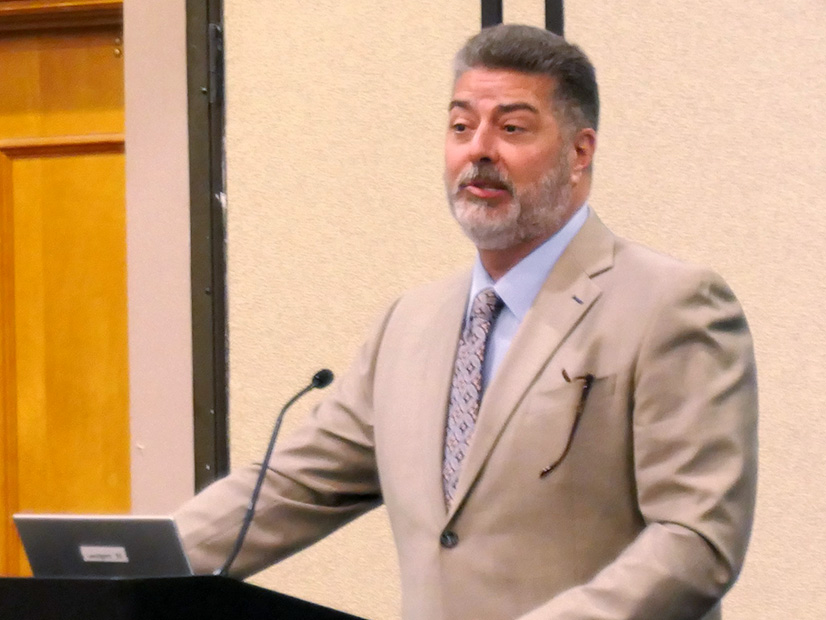INDIANAPOLIS — Senior Vice President Todd Hillman encapsulated MISO’s current pressure cooker environment of escalating data center demand, a precarious reliability situation and an overwhelmingly large interconnection queue at Infocast’s inaugural Midcontinent Clean Energy Summit Aug. 20.
Hillman said the days of 0.6 to 1% “anemic” load growth MISO-wide are in the rearview. He said MISO is bracing for 10% load growth in the next few years, driven by 14 to 16 GW of new facility demand.
But he added a caveat that MISO has poor visibility into the magnitude and entrances of large loads. Complicating matters, MISO is scraping its reserves as generation retirements continue.
“In the Midwest, we are at our reserve margins,” Hillman said. “We’ve already been driving to this reserve margin without any load growth.”
MISO expects 80-plus GW of retirements in its dispatchable fleet by 2042, Hillman said.
“We’re all waiting for that next thing: ‘Is it small nuclear reactors, is it long-duration storage, is it, is it, is it?’ My question is when will these technologies become commercially viable? Because we need them now,” he said.
For its part, MISO is trying to craft markets that place reliability front and center, Hillman said, invoking MISO’s proposed availability-based capacity accreditation for all resources, efforts to beef up scarcity pricing and exploring a possible new resource adequacy standard to replace the loss of load expectation.
Hillman said the MISO community should take notice of PJM’s capacity auction, where Dominion Energy’s entrance caused its zonal price to skyrocket to more than $440/MW-day. He said the unofficial data center capital of Arlington, Va., contained in the zone provides a cautionary tale for MISO. He said PJM and MISO, which can rely on one another in times of need, cannot count on the other’s imports when both regions are maxed out before emergency conditions descend.
“You can’t have two drunks leaning on each other. One of them is going to fall down. Now I’m not saying MISO is the drunk. I’m not saying that,” Hillman joked to audience laughter.
Hillman said the typical data center can be built in a matter of months. Generation, on the other hand, takes about six years to build, factoring in queue wait times and construction obstacles.
He said the situation is becoming desperate enough that Holtec International will attempt a restart of Palisades’ 800 MW reactor in Michigan after three years of retirement “to the low, low, low introductory price of $2.5 billion.”
Hillman also touched on the double-edged sword nature of MISO’s very active interconnection queue, which potentially could grow to 350 GW if MISO certifies all 123 GW of its 2022 queue submittals.
“The good news is that we have a very robust queue. The bad news is that we have a very robust queue,” Hillman said.
He said MISO’s active queue is so large engineers deem it “technically infeasible” to study potential interconnections.
Hillman reflected on how far MISO has come in two decades. He pointed out that the conference’s location, the Mariott Indianapolis North, was the site of MISO’s first annual meeting in 2005.
Back then, MISO was in the thick of what would become known as “Peakerfest,” Hillman said, where control room operators would over-commit peaking resources out of an abundance of caution. He also said MISO’s then approximately 5 GW wind fleet now stands at 35 GW.
“We’ve basically had three generation renaissances in the last 50 years,” Hillman said of the energy industry. He noted that from about 1969 to 1986 the nation built about 200 GW of coal power, which was followed by approximately 200 GW of new natural gas generation in the 1990s and the early 2000s surge in wind farms.
“Now we’re in the fourth renaissance, and that’s a load renaissance,” Hilman said. He called for a “higher level of debate” on the clean energy transition.
“We have always seen our industry come through,” he said. “It’s going to be quite the ride. It’s going to be quite the adventure.”




